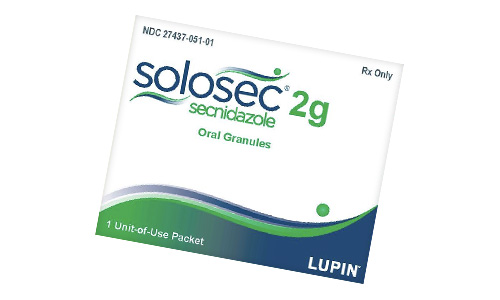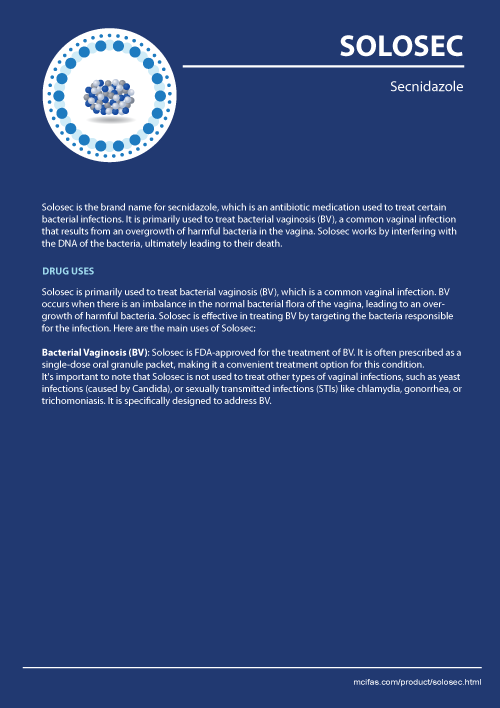Solosec Prescribing Information
Solosec is the brand name for secnidazole, which is an antibiotic medication used to treat certain bacterial infections. It is primarily used to treat bacterial vaginosis (BV), a common vaginal infection that results from an overgrowth of harmful bacteria in the vagina. Solosec works by interfering with the DNA of the bacteria, ultimately leading to their death.

Uses of Solosec
Solosec is primarily used to treat bacterial vaginosis (BV), which is a common vaginal infection. BV occurs when there is an imbalance in the normal bacterial flora of the vagina, leading to an overgrowth of harmful bacteria. Medicine is effective in treating BV by targeting the bacteria responsible for the infection. Here are the main uses:
- Bacterial Vaginosis (BV): Solosec is FDA-approved for the treatment of BV. It is often prescribed as a single-dose oral granule packet, making it a convenient treatment option for this condition.
It's important to note that antibiotic is not used to treat other types of vaginal infections, such as yeast infections (caused by Candida), or sexually transmitted infections (STIs) like chlamydia, gonorrhea, or trichomoniasis. It is specifically designed to address BV.
Dosage
The typical dosage of Solosec for the treatment of bacterial vaginosis (BV) is a single oral dose of 2 grams (g) of the medication, which is equivalent to one packet of Secnidazole granules.
Here's how to take Solosec:
- Empty Stomach: Medicine should be taken on an empty stomach, at least one hour before or two hours after a meal. This allows for better absorption of the medication.
- Packet Mixing: Follow the instructions provided with the Solosec packet to mix the granules with water. Typically, you'll dissolve the contents of one packet in a small amount of water (usually 1-2 ounces) to create a suspension.
- Oral Administration: Drink the entire suspension. It may have a slightly chalky taste, but it's essential to consume all of it.
- Avoid Alcohol: It's advisable to avoid alcohol for at least 72 hours (3 days) after taking Solosec, as the combination of secnidazole and alcohol can lead to disulfiram-like reactions, which may cause nausea, vomiting, and other unpleasant symptoms.
It's essential to take the full prescribed dose, even if your symptoms of BV improve before you finish the medication.
Side Effects of Solosec
Solosec is generally considered safe and well-tolerated, but like all medications, it can potentially cause side effects in some individuals. Common and less common side effects may include:
Common Side Effects:
- Headache
- Nausea
- Vomiting
- Diarrhea
- Abdominal pain or discomfort
- Vulvovaginal itching, burning, or discomfort
Less Common Side Effects:
- Dizziness
- Dry mouth
- Unpleasant metallic taste in the mouth
It's important to note that not everyone will experience these side effects, and many people may tolerate Solosec without any adverse reactions. If you do experience side effects, they are typically mild and temporary.
Serious allergic reactions to Solosec are rare but possible. Seek immediate medical attention if you experience any signs of a severe allergic reaction, which may include:
- Rash
- Itching or swelling, especially of the face, tongue, or throat
- Severe dizziness
- Difficulty breathing
Interaction with other drugs
Solosec may interact with certain other drugs or substances, potentially affecting its effectiveness or increasing the risk of side effects. It's important to inform your healthcare provider about all the medications, supplements, and herbal products you are taking before starting Solosec. Some potential interactions and considerations include:
- Alcohol: It's advisable to avoid alcohol for at least 72 hours (3 days) after taking this drug. The combination of secnidazole and alcohol can lead to disulfiram-like reactions, which may cause nausea, vomiting, and other unpleasant symptoms.
- Warfarin: Secnidazole may interact with warfarin, a blood-thinning medication, potentially affecting its anticoagulant effects. Monitoring of INR (International Normalized Ratio) levels may be necessary if you are taking both Solosec and warfarin.
- Certain Medications that Affect Liver Enzymes: Secnidazole is metabolized by the liver, so drugs that affect liver enzymes may influence its metabolism.
- Other Antibiotics: Concurrent use of Solosec with other antibiotics may alter the balance of microorganisms in the body and affect treatment outcomes.
- Oral Contraceptives: Some antibiotics can potentially reduce the effectiveness of oral contraceptives (birth control pills). While Secnidazole is not known to have this effect, it's advisable to use alternative contraception methods during your course of treatment and for a few days afterward, just to be cautious.
What to avoid while on Solosec
While taking Solosec to treat bacterial vaginosis (BV), it's important to follow certain guidelines and avoid specific substances or activities to ensure the medication's effectiveness and minimize the risk of side effects. Here's what to avoid while on Secnidazole:
- Alcohol: Avoid consuming alcohol for at least 72 hours (3 days) after taking Solosec. The combination of secnidazole and alcohol can lead to disulfiram-like reactions, which may cause nausea, vomiting, flushing, and other unpleasant symptoms.
- Oral Sex: Refrain from engaging in oral sex while you are undergoing treatment with Secnidazole. The medication may have a chalky taste and should be ingested, not applied topically or orally during sexual activity.
- Grapefruit and Grapefruit Juice: Some medications can interact with grapefruit and its juice, potentially affecting their absorption or metabolism. However, there is no specific information suggesting that Solosec interacts with grapefruit.
- Other Antibiotics: Concurrent use of multiple antibiotics can disrupt the balance of microorganisms in your body.
- Douching: Avoid vaginal douching or using other vaginal products during your treatment with Solosec, as these may interfere with the medication's effectiveness.
- Sexual Activity: It's generally safe to have sexual intercourse while taking Solosec. If you do engage in sexual activity, it's important to avoid using condoms or other barrier methods that contain nonoxynol-9, as this ingredient may interact with Secnidazole.
Contraindications of Solosec
Antibiotic may not be suitable for everyone, and there are certain contraindications or situations where its use is not recommended. Contraindications are factors or conditions that make the use of a medication potentially harmful or unsafe. Here are some contraindications and situations where Secnidazole should be used with caution or avoided:
- Hypersensitivity: If you have a known hypersensitivity or allergy to secnidazole or any of the ingredients in Solosec, you should not use this medication.
- Alcohol Use: As mentioned earlier, it is important to avoid alcohol for at least 72 hours (3 days) after taking this medicine. Combining secnidazole and alcohol can lead to disulfiram-like reactions, which may cause nausea, vomiting, flushing, and other unpleasant symptoms.
- Liver Disease: If you have severe liver disease or impaired liver function, your healthcare provider may need to adjust the dosage of Solosec or consider alternative treatments. Liver function should be monitored if Secnidazole is prescribed in such cases.
- Children: Antibiotic is not typically used in children, as it is primarily indicated for the treatment of bacterial vaginosis in adults.
Pregnancy and Solosec
Solosec is a medication used to treat bacterial vaginosis (BV). When it comes to the use of Secnidazole during pregnancy, it's important to consider the potential risks and benefits.
Here are some key points to keep in mind regarding Solosec and pregnancy:
- Limited Data: There is limited data available on the safety of Solosec during pregnancy because pregnant women are often excluded from clinical trials. Therefore, the full extent of its effects on pregnancy and the developing fetus may not be completely understood.
- Risk-Benefit Assessment: The decision to use Solosec during pregnancy should be made on a case-by-case basis.
- Alternative Treatments: These alternatives may include antibiotics like metronidazole or clindamycin, which are often prescribed for BV.
- Breastfeeding: There is limited information on whether secnidazole is excreted in breast milk.
» Drug Uses (format pdf, 0.2 Mb)



